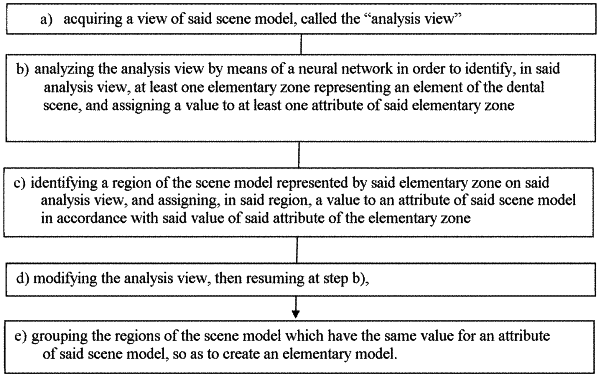| CPC G06T 7/11 (2017.01) [G06F 30/27 (2020.01); G06T 7/0012 (2013.01); G16H 50/50 (2018.01); A61C 7/002 (2013.01); G06N 3/08 (2013.01); G06T 2207/20081 (2013.01); G06T 2207/20084 (2013.01); G06T 2207/30036 (2013.01); G06V 2201/03 (2022.01)] | 7 Claims |

|
1. A method for cutting a three-dimensional model of a dental scene, or “scene model”, said method comprising the following steps:
a) acquiring a view of said scene model, called the “analysis view”;
b) analyzing the analysis view by means of a trained neural network in order to
identify, in said analysis view, at least one elementary zone representing an element of the dental scene, and
determine a value for at least one attribute of said elementary zone;
c) identifying a region of the scene model represented by said elementary zone on said analysis view, and assigning, to said region, a value of an attribute of said scene model, or “model attribute”, said value of the model attribute being dependent on the value of said attribute of the elementary zone,
d) modifying the analysis view, then resuming at step b),
the method comprising, after more than 10 cycles of steps b) to d), the following step:
e) grouping the regions of the scene model which have the same value for an attribute of said scene model, so as to create an elementary model;
in which the analysis view acquired at step a) and/or one or more of the analysis views modified at step d), are base analysis views obtained according to the following steps:
1) determining a predetermined orientation of the scene model, called the “base orientation”;
2) determining a set of different conditions of observation of the scene model positioned in said base orientation, called “base observation conditions”, the set of said base observation conditions is determined in such a way as to minimize the number of said base observation conditions and to maintain at a value greater than a predetermined threshold, for each of the base scene models of a group of base scene models, the ratio of the total surface area of the set of the elementary models, determined at step e), to the surface area of the scene model:
3) acquiring a set of base analysis views, each base analysis view being acquired under respective base observation conditions.
|